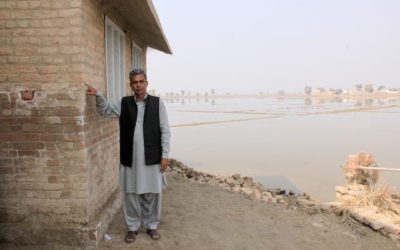Climate change adaptation strategies – migration
Climate change adaptation strategies – migration
Alex Randall
Alex is programme manager for the Climate and Migration Coalition Image:
Image: Two young members of a herder community in Tarialan, Uvs Province, Mongolia. UN Photo/Eskinder Debebe
Should migration be a climate change adaptation strategy
This post focuses on one key issue: should migration become a climate change adaptation strategy?
Usually adapting to climate change means staying put. When people talk about climate change adaptation they are usually talking about activities that might include:
- Building dams and sea defences to cope with rising sea levels
- Switching to crops that are better suited to drought conditions
- Upgrading city infrastructure like roads and sewers to better cope with flooding.
The activities all involve people staying put, and altering the infrastructure around them so they can better deal with climate change impacts.
Related:

Online Q&A: Covid-19, climate change and migration: 14th May at 3pm BST
Online Q&A session14th May at 3pm BST14th May at 3pm BSTHow does a city in lockdown deal with a sudden climate-driven disaster like a typhoon? The measures needed to cope with a sudden episode of displacement - such as mass emergency shelters - are exactly the...
Using migration as a climate adaptation strategy
But if migrating became a climate change adaptation strategy? What is moving to somewhere less impacted by climate change became a recognised what of adapting? This is exactly what the idea of migration as adaptation suggests.
The idea behind migration as adaptation is that people move from high risk places, to locations where they are safer from the impacts of climate change. Rather than this happening in an ad-hoc way, the idea behind migration as adaptation is that people are assisted in doing this.
This assistance could potentially mean a number of different things. For example it could involve:
- Helping people meet the costs of moving
- Training people in skills that will help the find work in their new location
- Creating better infrastructure like housing and healthcare in the places that people might move to
The idea of migration as adaptation is that with limited resources available to help people adapt, migrating might be better than trying to cope with climate change by adapting where they are.
Online Q&A: Covid-19, climate change and migration: 14th May at 3pm BST
Online Q&A session14th May at 3pm BST14th May at 3pm BSTHow does a city in lockdown deal with a sudden climate-driven disaster like a typhoon? The measures needed to cope with a sudden episode of displacement - such as mass emergency shelters - are exactly the...
Key resource
Climate, migration, neoliberalism
The lecture sketches out a history of neoliberalism, and then looks at how the culmination of this political thinking is reflected in the policies that are being created to address climate change and migration.
People are already using migration as an adaptation strategy
Although migration as an adaptation strategy doesn’t enjoy much official recognition by governments, it is something many people are doing anyway. Most people do not call what they are are doing ‘migration as adaptation’ but many people are already moving away from places that are badly impacted by climate change.
Usually they are moving away from rural areas where farming is becoming increasingly hard due to drought. Often they move to nearby town and cities and seek alternative non-farming work. Although people who do this may not define themselves as ‘climate migrants’ and probably wouldn’t describe what they have done as a form of climate adaptation – none the less they have used migration as a strategy for adapting to climate impacts.
Key resource
Online Q&A: Covid-19, climate change and migration: 14th May at 3pm BST
Online Q&A session14th May at 3pm BST14th May at 3pm BSTHow does a city in lockdown deal with a sudden climate-driven disaster like a typhoon? The measures needed to cope with a sudden episode of displacement - such as mass emergency shelters - are exactly the...
Related video
Climate, migration, neoliberalism
The lecture sketches out a history of neoliberalism, and then looks at how the culmination of this political thinking is reflected in the policies that are being created to address climate change and migration.
Controversies around migration as a climate adaptation strategy
It is generally accepted that viewing migration as a climate adaptation strategy is more positive that viewing climate-linked migration only as a problem. Framing climate-linked migration as a form of adaptation has provided a counterbalance to the apocalyptic narratives of “millions of climate refugees”. Migration as adaptation sees migration as something that can – in the right circumstances – be positive and helpful.
However the idea of migration as a climate adaptation strategy is not without controversy.
Some states are likely to see the concept as one that could create new migratory routes into their country. They may be resistant to the concept because of widespread anti-migrant sentiment within their own policy makers or the wider public.
Others question migration as adaptation from other perspectives.
There are issues around rights and consent. For example migration as adaptation sounds positive when people are choosing to move, and are empowered to do so through funding and education. But some fear that the concept could provide states with a pre-text to forcibly move people.
Others argue that migration as adaptation places the responsibility for adapting with the people who are hardest hit by climate change and have also done the least to cause it.
By suggesting that people can migrate as an adaptation strategy might allow high emitting governments to shirk their responsibility to reduce emissions and help people adapt in other ways.
In spite of these criticism we believe that migration as an adaptation strategy does hold great potential, provided is is managed in the right way with full respect for the rights of people involved.
Related video
Climate, migration, neoliberalism
The lecture sketches out a history of neoliberalism, and then looks at how the culmination of this political thinking is reflected in the policies that are being created to address climate change and migration.
Climate, migration, neoliberalism
The lecture sketches out a history of neoliberalism, and then looks at how the culmination of this political thinking is reflected in the policies that are being created to address climate change and migration.
Climate change and migration: predictions, politics and policy
Get to grips with one of the defining issues of the 21st Century – how will climate change re-shape migration across the world. Join a free, 100% online course to investigate this essential topic
Event: Migration and displacement at the climate talks
How are migration and displacement being dealt with at the international climate change talks? Find out more with our online event
Event: Climate change and Migration 101. 4 December
Get to grips with the links between climate and the movement of people
Event: hot wars- Climate change, armed conflict and security. 15 November
What do we know about the links between climate change and conflict? Will life on a hotter planet be on with more armed violence?
Briefing: climate change and migration. 24 October, London
An evening briefing exploring the links between climate change and migration. Find out more and book places. 24 October, London
Workshop on climate change and migration. 16 October, London
Workshop on climate change and migration. A half-day session exploring the links between climate change and migration. 16 October, London






